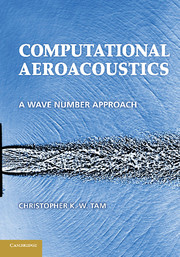Book contents
- Frontmatter
- Contents
- Preface
- 1 Finite Difference Equations
- 2 Spatial Discretization in Wave Number Space
- 3 Time Discretization
- 4 Finite Difference Scheme as Dispersive Waves
- 5 Finite Difference Solution of the Linearized Euler Equations
- 6 Radiation, Outflow, and Wall Boundary Conditions
- 7 The Short Wave Component of Finite Difference Schemes
- 8 Computation of Nonlinear Acoustic Waves
- 9 Advanced Numerical Boundary Treatments
- 10 Time-Domain Impedance Boundary Condition
- 11 Extrapolation and Interpolation
- 12 Multiscales Problems
- Chapter 13 Complex Geometry
- 14 Continuation of a Near-Field Acoustic Solution to the Far Field
- 15 Design of Computational Aeroacoustic Codes
- Appendix A Fourier and Laplace Transforms
- Appendix B The Method of Stationary Phase
- Appendix C The Method of Characteristics
- Appendix D Diffusion Equation
- Appendix E Accelerated Convergence to Steady State
- Appendix F Generation of Broadband Sound Waves with a Prescribed Spectrum by an Energy-Conserving Discretization Method
- Appendix G Sample Computer Programs
- References
- Index
14 - Continuation of a Near-Field Acoustic Solution to the Far Field
Published online by Cambridge University Press: 05 October 2012
- Frontmatter
- Contents
- Preface
- 1 Finite Difference Equations
- 2 Spatial Discretization in Wave Number Space
- 3 Time Discretization
- 4 Finite Difference Scheme as Dispersive Waves
- 5 Finite Difference Solution of the Linearized Euler Equations
- 6 Radiation, Outflow, and Wall Boundary Conditions
- 7 The Short Wave Component of Finite Difference Schemes
- 8 Computation of Nonlinear Acoustic Waves
- 9 Advanced Numerical Boundary Treatments
- 10 Time-Domain Impedance Boundary Condition
- 11 Extrapolation and Interpolation
- 12 Multiscales Problems
- Chapter 13 Complex Geometry
- 14 Continuation of a Near-Field Acoustic Solution to the Far Field
- 15 Design of Computational Aeroacoustic Codes
- Appendix A Fourier and Laplace Transforms
- Appendix B The Method of Stationary Phase
- Appendix C The Method of Characteristics
- Appendix D Diffusion Equation
- Appendix E Accelerated Convergence to Steady State
- Appendix F Generation of Broadband Sound Waves with a Prescribed Spectrum by an Energy-Conserving Discretization Method
- Appendix G Sample Computer Programs
- References
- Index
Summary
By now, it is abundantly clear that all computational aeroacoustics (CAA) simulations can only be carried out in a finite, and in most cases, as small as possible, computational domain. A critical problem is how to continue the numerical solution to the far field. In some cases, the acoustic field consists of discrete frequency sound or tones. But in most cases, such as jet noise, the sound field is broadband and random. In aeroacoustics, most broadband noise is the result of turbulence. Turbulence is random and definitely nondeterministic, and the same is true of the radiated noise. The nondeterministic nature of the noise of turbulence makes its continuation to the far field a much more challenging task.
Mathematically, the problem of extending a near-field acoustic solution to the far field is akin to the mathematical procedure of “analytic continuation” in complex variables. Analytic continuation extends an analytic function defined in a limited domain to a large domain. Because the ideas behind the two problems are similar, the word “continuation” is used here to indicate the objective and intent.
At high Reynolds numbers, a flow is inevitably turbulent. As noted earlier, a turbulent flow is chaotic and random. For a turbulent flow such as that of a high Reynolds number jet, the solution is nonunique. Nonuniqueness is a characteristic of turbulence. Only the statistical averaged quantities are stationary with respect to time. This being the case, it brings forth the question of what physical variables should be continued to the far field. There is also the question of cost in performing the continuation. One may wish to continue the entire turbulence information to the far field, but the computational cost is likely to be prohibitive. Thus, this may not be a good idea. From a practical standpoint, the crucial information one needs in the far field is the noise directivity and spectra. If, indeed, the noise spectra and directivity are the information required in the far field, then a not so expensive computational procedure may be developed to continue this information from the near to the far field. In this chapter only the continuation of the spectra and directivity of turbulence noise are considered.
- Type
- Chapter
- Information
- Computational AeroacousticsA Wave Number Approach, pp. 298 - 328Publisher: Cambridge University PressPrint publication year: 2012



